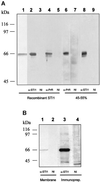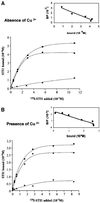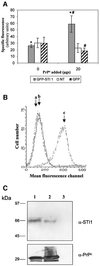Stress-inducible protein 1 is a cell surface ligand for cellular prion that triggers neuroprotection
- PMID: 12093732
- PMCID: PMC125391
- DOI: 10.1093/emboj/cdf325
Stress-inducible protein 1 is a cell surface ligand for cellular prion that triggers neuroprotection
Abstract
Prions are composed of an isoform of a normal sialoglycoprotein called PrP(c), whose physiological role has been under investigation, with focus on the screening for ligands. Our group described a membrane 66 kDa PrP(c)-binding protein with the aid of antibodies against a peptide deduced by complementary hydropathy. Using these antibodies in western blots from two-dimensional protein gels followed by sequencing the specific spot, we have now identified the molecule as stress-inducible protein 1 (STI1). We show that this protein is also found at the cell membrane besides the cytoplasm. Both proteins interact in a specific and high affinity manner with a K(d) of 10(-7) M. The interaction sites were mapped to amino acids 113-128 from PrP(c) and 230-245 from STI1. Cell surface binding and pull-down experiments showed that recombinant PrP(c) binds to cellular STI1, and co-immunoprecipitation assays strongly suggest that both proteins are associated in vivo. Moreover, PrP(c) interaction with either STI1 or with the peptide we found that represents the binding domain in STI1 induce neuroprotective signals that rescue cells from apoptosis.
Figures








Similar articles
-
Prion protein and its ligand stress inducible protein 1 regulate astrocyte development.Glia. 2009 Oct;57(13):1439-49. doi: 10.1002/glia.20861. Glia. 2009. PMID: 19243016
-
PrP cooperates with STI1 to regulate SOD activity in PrP-deficient neuronal cell line.Biochem Biophys Res Commun. 2005 Mar 4;328(1):14-9. doi: 10.1016/j.bbrc.2004.12.132. Biochem Biophys Res Commun. 2005. PMID: 15670743
-
Short-term memory formation and long-term memory consolidation are enhanced by cellular prion association to stress-inducible protein 1.Neurobiol Dis. 2007 Apr;26(1):282-90. doi: 10.1016/j.nbd.2007.01.005. Epub 2007 Jan 25. Neurobiol Dis. 2007. PMID: 17329112
-
Cellular prion protein signaling in serotonergic neuronal cells.Ann N Y Acad Sci. 2007 Jan;1096:106-19. doi: 10.1196/annals.1397.076. Ann N Y Acad Sci. 2007. PMID: 17405922 Review.
-
Physiological role of the cellular prion protein.Vet Res. 2008 Jul-Aug;39(4):9. doi: 10.1051/vetres:2007048. Epub 2007 Nov 27. Vet Res. 2008. PMID: 18073096 Review.
Cited by
-
Stress-inducible phosphoprotein 1 (HOP/STI1/STIP1) regulates the accumulation and toxicity of α-synuclein in vivo.Acta Neuropathol. 2022 Nov;144(5):881-910. doi: 10.1007/s00401-022-02491-8. Epub 2022 Sep 19. Acta Neuropathol. 2022. PMID: 36121476 Free PMC article.
-
Truncated prion protein and Doppel are myelinotoxic in the absence of oligodendrocytic PrPC.J Neurosci. 2005 May 11;25(19):4879-88. doi: 10.1523/JNEUROSCI.0328-05.2005. J Neurosci. 2005. PMID: 15888663 Free PMC article.
-
The low-density lipoprotein receptor-related protein 1 (LRP1) mediates the endocytosis of the cellular prion protein.Biochem J. 2007 Feb 15;402(1):17-23. doi: 10.1042/BJ20061736. Biochem J. 2007. PMID: 17155929 Free PMC article.
-
PrP C as a Transducer of Physiological and Pathological Signals.Front Mol Neurosci. 2021 Nov 22;14:762918. doi: 10.3389/fnmol.2021.762918. eCollection 2021. Front Mol Neurosci. 2021. PMID: 34880726 Free PMC article. Review.
-
MEK1 transduces the prion protein N2 fragment antioxidant effects.Cell Mol Life Sci. 2015 Apr;72(8):1613-29. doi: 10.1007/s00018-014-1777-y. Epub 2014 Nov 13. Cell Mol Life Sci. 2015. PMID: 25391659 Free PMC article.
References
-
- Aguzzi A. and Weissmann,C. (1997) Prion research: the next frontiers. Nature, 389, 795–798. - PubMed
-
- Ausubel F.M., Brent,K., Struhl,K., Kingston,R.E., Moore,D.D., Seidman,J.G. and Smith,J.A. (eds) (1993) Current Protocols in Molecular Biology. Wiley Interscience, New York.
-
- Beck K., Hunter,I. and Engel,J. (1990) Structure and function of laminin: anatomy of a multidomain glycoprotein. FASEB J., 4, 148–160. - PubMed
-
- Blatch G.L., Lassle,M., Takatori,T., Grandhi,T., Kundra,V. and Zetter,B.R. (1995) Molecular characterization of extendin: a protein localized in extending pseudopodia. Proc. Am. Assoc. Cancer Res., 36, 68.
-
- Blatch G.L., Lassle,M., Zetter,B.R. and Kundra,V. (1997) Isolation of a mouse cDNA encoding mSTI1, a stress-inducible protein containing the TPR motif. Gene, 194, 277–282. - PubMed
Publication types
MeSH terms
Substances
LinkOut - more resources
Full Text Sources
Other Literature Sources
Research Materials

